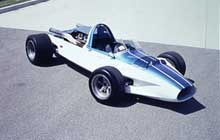 LAS VEGAS — Chevrolet rolls out the legendary CERV-I (Chevrolet Engineering Research Vehicle) — at the 1997 SEMA show. The 1960 CERV-I is the first of four high performance research vehicles produced by Chevrolet over a 35 year period.
LAS VEGAS — Chevrolet rolls out the legendary CERV-I (Chevrolet Engineering Research Vehicle) — at the 1997 SEMA show. The 1960 CERV-I is the first of four high performance research vehicles produced by Chevrolet over a 35 year period.FOR RELEASE: November 6, 1997
CONTACT: Chevrolet Communications
Phone: 1-800-CHEVY-MI 0r 810-492-8841
Fax: (810) 492-8853
 LAS VEGAS — Chevrolet rolls out the legendary CERV-I (Chevrolet Engineering Research Vehicle) — at the 1997 SEMA show. The 1960 CERV-I is the first of four high performance research vehicles produced by Chevrolet over a 35 year period.
LAS VEGAS — Chevrolet rolls out the legendary CERV-I (Chevrolet Engineering Research Vehicle) — at the 1997 SEMA show. The 1960 CERV-I is the first of four high performance research vehicles produced by Chevrolet over a 35 year period.
Zora Arkus-Duntov developed it as a platform for engineers to develop and refine Chevrolet body, chassis and suspension systems. Its impressive performance on the test track drove him to have higher aspirations — the checkered flag at Indy. Regretfully, due to a ban on racing by Chevrolet at the time, Duntov was unable to compete — he settled for a few demo laps at the U.S. Grand Prix in 1960.
Originally, the CERV-I was equipped with a 283 cu. in. small block V8 engine that delivered 350 horsepower while weighing only 350 lbs. — an impressive power-to-weight ratio rarely achieved in even high performance aircraft of its time. This lightweight status was due to an intensive use of aluminum and magnesium engine components — saving over 175 lbs. Duntov employed a Corvette-type 4-speed transmission to harness this power.
Complementing its lightweight powerplant, designer, Larry Shinoda constructed CERV-I’s body structure out of fiberglass-reinforced plastic — weighing in at only 80 lbs. This body structure was attached to a very rigid 125 lb. chrome-molybdenum tube constructed frame. Combining these lightweight components helped the CERV-I weigh in at a lean 1,600 lbs.
CERV-I’s chassis system also features a four-wheel independent suspension with a unique rear multilink system that’s very similar to systems used in modern automobiles. The brake system — also ahead of its time — employs an innovative two-piston master cylinder that eliminates the chance of complete brake failure.
Over time, with his eye on even greater performance, Duntov refitted the CERV-I with its current 377 cu. in. aluminum small block, an advanced Rochester fuel injection system and Indy-style tires and wheels. To match this mechanical updating, Shinoda redesigned its streamlined body structure for greater aerodynamics. Today the CERV-I appears in this second-generation form. It’s owned by Mike Yager, President of Mid America Designs, and is part of the Mid America Designs car collection.
| 1960 CERV-I Spec Chart | |
| Engine | 377 cu. in. aluminum V8 |
| Transmission | Fully synchronized 4-speed manual |
| Driveline Configuration | Rear engine, rear-wheel drive |
| Fuel Delivery System | Rochester fuel injection |
| Fuel Tank | Two rubber bladder fuel cells with 20 gallon total capacity |
| Frame | Body-on-frame construction from tubular chrome-moly steel |
| Suspension | Four-wheel independent |
| Front — Independent, variable rate springs with shock absorbers and front stabilizer bar | |
| Rear — Independent multilink, variable rate springs with “double-acting” shock absorbers | |
| Brakes | Front disc/rear drum (similar system to the HD type available on 1960 Corvette), two piston master cylinder |
| Steering | Recirculating ball type steering gear with 12:1 ratio |
| Wheels | Cast magnesium alloy |
| Wheelbase | 96 inches |
| Weight | 1,600 lbs. |
| Maximum Speed | 206 mph |
Article ID: 858
Created: August 18, 2014
Last Updated: August 18, 2014
Online URL: https://www.corvetteactioncenter.com/tech/knowledgebase/article/gm-press-release-november-6-1997-cerv-i-an-automotive-benchmark-858.html